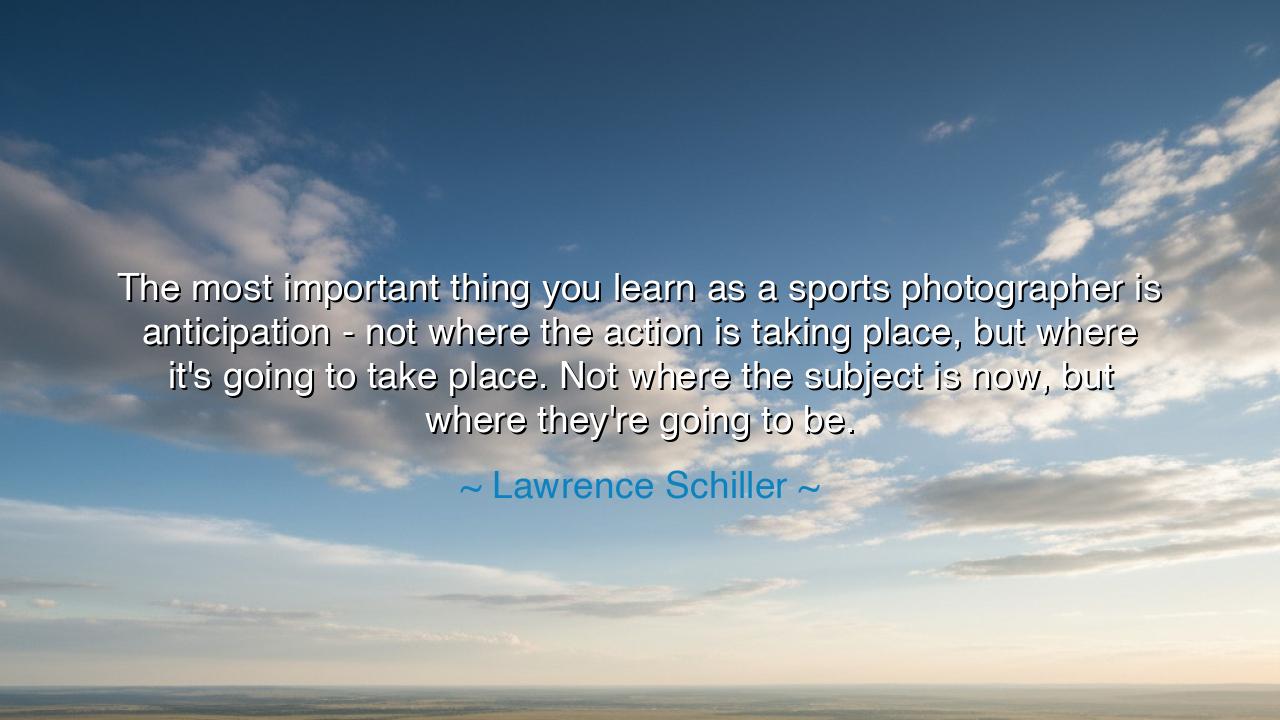
The most important thing you learn as a sports photographer is
The most important thing you learn as a sports photographer is anticipation - not where the action is taking place, but where it's going to take place. Not where the subject is now, but where they're going to be.






When Lawrence Schiller declared, “The most important thing you learn as a sports photographer is anticipation – not where the action is taking place, but where it’s going to take place. Not where the subject is now, but where they’re going to be,” he unveiled a truth that transcends photography and touches the very rhythm of life. His words remind us that mastery is not found in reacting to the present alone, but in perceiving the unfolding of the future. To capture greatness, whether in an image or in life itself, one must learn to look beyond the moment and into the direction where destiny is moving.
The ancients knew this wisdom well. They spoke often of foresight as a divine gift, given to prophets and wise men. To merely see the present is a faculty of all; to foresee the flow of events is the mark of visionaries. In Schiller’s craft, the still image becomes timeless only because the photographer stood not where the crowd’s eyes were fixed, but where the play would break open, where the hero would leap, where the ball would strike. Such anticipation is an art of the spirit, requiring patience, attentiveness, and trust in one’s instincts.
Think of the general Hannibal, who defeated Rome’s legions at Cannae. His triumph was not in overwhelming strength but in foresight. He did not wait for the enemy to strike—he arranged his forces in a way that predicted the Romans’ every move, encircling them before they could even grasp their peril. Like the photographer anticipating the perfect frame, Hannibal looked not to where the Romans were, but to where they would be. His foresight carved his place into history.
Schiller’s reflection also teaches us about humility. To focus on “where the subject is now” is to grasp only what is obvious. But life does not reward those who chase the obvious. It rewards those who can step back, breathe deeply, and discern the invisible thread leading from present to future. The great athlete trains not for today’s body but tomorrow’s strength. The wise leader plans not for this season alone but for generations to come. The artist waits not for the crowd’s cheer but for the timeless moment that will echo long after silence falls.
This wisdom calls us to sharpen our own powers of anticipation. We are urged to cultivate watchfulness, to study patterns, to notice the subtle signs that reveal what comes next. Just as the sports photographer learns to follow the glances, the shifting stances, the momentum of movement, so too must we learn to read the flow of life—to see opportunity before it arrives, to prepare for challenge before it strikes, to meet the future as if we had already walked its path.
The lesson is plain: do not live only in the instant, blind to what lies ahead. Train your mind and spirit to watch with patience, to sense the direction of unfolding events, and to act not when all is obvious, but when the moment is still forming. It is this foresight that distinguishes the master from the novice, the wise from the unprepared, the visionary from the crowd.
Practically, this means pausing before reacting, asking not only “What is happening now?” but also “Where is this leading?” In your work, anticipate what will be needed tomorrow, not merely what is asked today. In your relationships, sense the unspoken currents, not just the words. In your own growth, prepare for the person you are becoming, not only the one you are.
Thus, Lawrence Schiller’s words shine as a teaching for all generations: the secret of mastery lies in anticipation. See not only the present moment, but the path unfolding from it. For the greatest images, the greatest victories, the greatest lives are not captured in what is, but in what is about to be.






AAdministratorAdministrator
Welcome, honored guests. Please leave a comment, we will respond soon